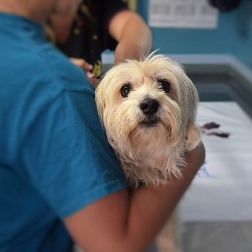How to Find the Right Veterinary Technician School near Big Timber Montana
 Achieving your lifelong goal of working with and helping pets by enrolling in a veterinary technician college near Big Timber MT could initially seem like an overwhelming endeavor. After all, you must locate and enroll in a program that will furnish the proper training to ensure that you can be successful as a vet tech. But just how do you approach assessing and contrasting colleges so that you can make the proper choice? Many aspiring students start their due diligence process by searching for schools that are near their residences. Once they have located some nearby schools, they determine which ones have the cheapest tuition and focus on those. Although cost and location are significant factors when comparing veterinary technician schools, they are by no means the only important ones when making your assessments. Qualifiers such as accreditation and internship programs need to be considered also. The main idea is that there are questions you should be asking the vet technician schools you are considering before you make an ultimate selection. We have furnished several within this article in order to help get you started, but before we review them we’ll discuss the various responsibilities of vet techs and the training alternatives offered.
Achieving your lifelong goal of working with and helping pets by enrolling in a veterinary technician college near Big Timber MT could initially seem like an overwhelming endeavor. After all, you must locate and enroll in a program that will furnish the proper training to ensure that you can be successful as a vet tech. But just how do you approach assessing and contrasting colleges so that you can make the proper choice? Many aspiring students start their due diligence process by searching for schools that are near their residences. Once they have located some nearby schools, they determine which ones have the cheapest tuition and focus on those. Although cost and location are significant factors when comparing veterinary technician schools, they are by no means the only important ones when making your assessments. Qualifiers such as accreditation and internship programs need to be considered also. The main idea is that there are questions you should be asking the vet technician schools you are considering before you make an ultimate selection. We have furnished several within this article in order to help get you started, but before we review them we’ll discuss the various responsibilities of vet techs and the training alternatives offered.
The Job of a Vet Tech in Big Timber MT
 Among the initial decisions that you will have to make is whether you plan to train as a veterinary technician, assistant or technologist. Part of your decision might be based on the amount of time and money that you have to invest in your training, but the principal determiner will most likely be which specialty appeals to you the most. What techs and assistants share in common is that they each work under the direct supervision of a practicing and licensed veterinarian. And although there are a number of functions that they can carry out within the Big Timber MT veterinary clinic or hospital, they can’t prescribe medications, diagnose conditions, or conduct surgeries. In those areas they can only furnish assistance to a licensed vet. There are technicians and technologists that work away from the typical vet practice, such as for zoos, animal shelters or law enforcement. Let’s take a look at the job functions and training prerequisites for each position.
Among the initial decisions that you will have to make is whether you plan to train as a veterinary technician, assistant or technologist. Part of your decision might be based on the amount of time and money that you have to invest in your training, but the principal determiner will most likely be which specialty appeals to you the most. What techs and assistants share in common is that they each work under the direct supervision of a practicing and licensed veterinarian. And although there are a number of functions that they can carry out within the Big Timber MT veterinary clinic or hospital, they can’t prescribe medications, diagnose conditions, or conduct surgeries. In those areas they can only furnish assistance to a licensed vet. There are technicians and technologists that work away from the typical vet practice, such as for zoos, animal shelters or law enforcement. Let’s take a look at the job functions and training prerequisites for each position.
- Vet Assistants in most cases will have undergone a structured training program, either as an apprentice or intern in a practice, or by completing a certificate program at a community college or vocational school. As the name implies, their job function is to assist the veterinarians and vet technicians in the completion of their duties. Generally they are not associated with more complicated tasks, such as assisting with surgeries. A few of their usual functions may include working at the front desk, preparing and cleaning examination rooms and equipment, or controlling animals during exams.
- Vet Technicians go through more advanced training compared to assistants and normally obtain a 2 year Associate Degree, preferably from an American Veterinary Medical Association (AVMA) accredited program. They are in a sense the veterinary equivalent of medical nurses, since their general job function is to assist vets with diagnosing and treating animal patients. Where they vary from veterinary assistants is that they are included in more involved functions, such as assisting with surgeries or administering medicine. All states presently mandate that veterinary technicians pass a credentialing exam for either licensing, registration or certification.
- Vet Technologists are similar to veterinary technicians and essentially perform the same job functions. They are required to obtain a Bachelor’s Degree in veterinary technology, which generally takes four years to complete. Therefore the main distinction between a vet technologist and a technician is the technologist’s higher level of education. But with an advanced degree comes more job options, increased salaries and potential management positions. They are also required to pass a credentialing examination for either licensing, registration or certification.
Vet techs and technologists may specialize in areas such as anesthesia, internal medicine or urgent care. Many may obtain certification from the American Association for Laboratory Animal Science (AALAS) to work in Big Timber MT laboratories or research facilities also.
Veterinary Technician Online Schools Offered in Big Timber
 An approach that might be a solution for those with a hectic lifestyle or who are working full-time while going to veterinary school is to enroll in an online training program. Because the classes are made available through the internet, students can attend on their own schedule wherever a computer is available. The course of study is taught using various venues, including videos, slide shows and live streaming webinars. And since many vet tech and technologist degrees require practical training, that part can typically be fulfilled as an internship or work study program at a local Big Timber MT veterinary practice or hospital. Distance learning, as it is also called, may in many instances reduce the cost of your education. Tuition and supplementary costs, for instance for travel and study supplies, can be cheaper compared to more conventional classroom programs. Just be sure that the online school that you enroll in is accredited, either by the AVMA or another nationally certified accrediting organization. With the online courses and the clinical training, everything is furnished for a comprehensive education. So if you are disciplined enough to learn in this more independent mode, an online vet tech school may be the ideal option for you.
An approach that might be a solution for those with a hectic lifestyle or who are working full-time while going to veterinary school is to enroll in an online training program. Because the classes are made available through the internet, students can attend on their own schedule wherever a computer is available. The course of study is taught using various venues, including videos, slide shows and live streaming webinars. And since many vet tech and technologist degrees require practical training, that part can typically be fulfilled as an internship or work study program at a local Big Timber MT veterinary practice or hospital. Distance learning, as it is also called, may in many instances reduce the cost of your education. Tuition and supplementary costs, for instance for travel and study supplies, can be cheaper compared to more conventional classroom programs. Just be sure that the online school that you enroll in is accredited, either by the AVMA or another nationally certified accrediting organization. With the online courses and the clinical training, everything is furnished for a comprehensive education. So if you are disciplined enough to learn in this more independent mode, an online vet tech school may be the ideal option for you.
Questions to Ask Big Timber MT Vet Tech Programs
 By now you should have decided on which veterinary credential that you wish to obtain, and if you intend to study online or attend a school on campus. Since there are an abundance of vet community colleges, vocational and trade schools in the Big Timber MT area and across the United States, you need to ask some relevant questions to help fine tune your list of alternatives. As we pointed out in our opening, many potential students start by prioritizing location and tuition expense. But we have already touched on other essential qualifiers, for example internship programs and accreditation. And of course you want to choose a college that offers the degree and specialty that you are interested in. These and other qualifications are reviewed in the list of questions that you should ask the vet tech colleges that you are looking at.
By now you should have decided on which veterinary credential that you wish to obtain, and if you intend to study online or attend a school on campus. Since there are an abundance of vet community colleges, vocational and trade schools in the Big Timber MT area and across the United States, you need to ask some relevant questions to help fine tune your list of alternatives. As we pointed out in our opening, many potential students start by prioritizing location and tuition expense. But we have already touched on other essential qualifiers, for example internship programs and accreditation. And of course you want to choose a college that offers the degree and specialty that you are interested in. These and other qualifications are reviewed in the list of questions that you should ask the vet tech colleges that you are looking at.
Is the Vet Program Accredited? It’s imperative that you make sure that the veterinary technician school you choose is accredited by a regional or national accrediting organization. As earlier stated, among the most highly regarded is the American Veterinary Medical Association (AVMA). Trade schools and colleges that are accredited by the AVMA have gone through a demanding screening process that verifies you will receive a superior education. Also, accreditation is important if you are applying for a student loan or financial assistance, since many programs are not offered for non-accredited colleges. Last, having a certificate or degree from an accredited program is often a requirement for employment for many Big Timber MT area veterinary clinics and hospitals.
What is the School’s Reputation? The veterinarian vocational school or college and program you choose should have an outstanding reputation within the veterinarian field. You can initiate your due diligence by asking the colleges you are looking at for testimonials from the employers in their job assistance network. Other suggestions include looking on internet school ranking websites and contacting the school’s accrediting organizations as well. You can ask the Montana school licensing authority if there have been any complaints or infractions concerning your specific schools. As a final suggestion, contact some Big Timber MT veterinary clinics that you may want to work for after you receive your training. Find out what they think of your school choices. They may even recommend some schools not on your list.
Are there Internship Programs? The most effective means to get practical hands on training as a vet tech is to work in a medical setting. Ask if the colleges you are considering have internship programs established with Big Timber MT veterinarians, vet hospitals or clinics. Almost all veterinary medicine programs require practical training and many provide it by means of internships. Not only will the experience be valuable as far as the practical training, but an internship may also help build associations in the local veterinary community and help in the search for a job after graduation.
Is Job Placement Offered? Getting a job after graduating from a vet tech program may be challenging without the assistance of a job placement program. First, find out what the graduation rates are for the programs you are considering. A lower rate might suggest that the instructors were unqualified to teach the course of study or that some students were unhappy with the program and dropped out. Next, check that the colleges have a job placement program and ask what their placement rates are. A higher placement rate might mean that the school has an outstanding reputation within the Big Timber MT vet community and has a considerable network of contacts for student placements. A low rate may mean that the training is not highly thought of by employers or that the job assistance program is a failure at placing students.
How Large are the Classes? If the classes are larger, you may receive little or no individualized instruction from the teachers. Solicit from the Big Timber MT schools you are researching what their class teacher to student ratios are. You might also want to participate in some classes (if practical) to monitor the interaction between teachers and students. Get feedback from students relating to the quality of instruction. Also, speak with the teachers and determine what their qualifications are as well as their approaches to teaching.
Where is the College Located? Yes, we already covered location, but there are a couple of more points to make on the subject. If you are planning to drive to your vet tech classes from your Big Timber MT home, you must confirm that the commuting time is compatible with your schedule. For instance, driving during the weekend to check out the route won’t be the same as the commute during rush hour traffic, particularly if the campus is located in or near a larger city. In addition, if you do opt to enroll in a college in another state or even outside of your County of residence, there may be higher tuition fees particularly for community and state colleges. On the other hand, attending online classes may be an alternative that will provide you with more flexibility and reduce the need for travel.
Do the Classes Fit Your Schedule? And last, it’s essential that you ascertain if the veterinary programs you are considering offer class times flexible enough to fit your schedule. For instance, many students continue working full time and can only attend classes on the weekends or in the evenings near Big Timber MT. Others might only be able to attend class in the morning or in the afternoon. Confirm that the class times you require are offered prior to enrolling. In addition, determine if you can make-up classes that you might miss due to illness, work or family issues. You might find that an online college is the best solution to fit your vet training into your hectic life.
Enrolling in a Vet Tech School near Big Timber MT?
If you have decided to attend a Veterinary Technician Program in the Big Timber Montana area, then you may find the following information about the location of your school campus interesting and informing.
Big Timber, Montana
Big Timber takes its name from Big Timber Creek, which was named by William Clark because of the large cottonwood trees.[5] The post office was established in 1880, closed, then reopened in 1882 with Ella Burns as postmaster.[6] As a stop on the Northern Pacific Railroad, Big Timber became a major wool-shipping depot. It became the county seat in 1895.[7] A fire in 1908 destroyed half the commercial buildings and a third of the residential homes.[7]
Big Timber has a cool semi-arid climate (Köppen BSk) bordering on a humid continental climate (Dfb). Although winters can be frigid, frequent chinook winds will raise temperatures above 50 °F or 10 °C on an average twenty days between December and February, and have raised them to or above 68 °F or 20 °C on ten occasions during these months since 1894.[9] The chinooks mean Big Timber's 31.3 days per year failing to top freezing is among the fewest in Montana, with the average window for such maxima being from November 11 to March 18.[9] In the absence of chinooks, temperatures fall to 0 °F or −17.8 °C on seventeen mornings during an average winter, although such temperatures were reached just once in 1999/2000 but as many as thirty-four times during the very cold winters of 1935/1936 and 1978/1979. The average window for zero temperatures is from December 4 to February 25. The coldest temperature in Big Timber has been −47 °F (−43.9 °C) during the notorious 1936 cold wave on February 15, whilst February 1936 was also the coldest month on record at 5.0 °F or −15.0 °C, shading January 1916 which averaged 5.5 °F or −14.7 °C.
Spring is typically windy with temperatures nearly so variable as in winter: the last frost typically arrives on May 19, but temperatures have reached 80 °F or 26.7 °C as early as March 22 of 1928 and have fallen to zero Fahrenheit as late as April 13, 1928 and April 12, 1997. Late in spring thunderstorms increase in frequency and during late spring and early summer these provide most of Big Timber's annual precipitation. The wettest calendar year since 1894 has been 1957 with 25.71 inches (653.0 mm) and the driest 1939 with 9.38 inches (238.3 mm), whilst the wettest single month has been May 1981 with 7.69 inches (195.3 mm)
Enroll in the Right Veterinary Technician Program near Big Timber MT
 Choosing the ideal veterinary technician program is a crucial first step to beginning a rewarding career providing care and treatment for pets and livestock. Future students thinking about vet tech programs must make their determination based on multiple key issues. Veterinary technicians and technologists work in vet clinics, animal hospitals and animal shelters. They typically handle administrative responsibilities and assist the veterinarian with the animals as needed. As we have covered, it’s imperative that you select a veterinary medicine program that is both accredited and has an outstanding reputation within the field. This goes for vet tech online colleges as well. By asking the questions included in our checklist for assessing schools, you will be able to reduce your choices so that you can make your final decision. And by choosing the best school, you can achieve your goal of becoming a vet tech in Big Timber MT.
Choosing the ideal veterinary technician program is a crucial first step to beginning a rewarding career providing care and treatment for pets and livestock. Future students thinking about vet tech programs must make their determination based on multiple key issues. Veterinary technicians and technologists work in vet clinics, animal hospitals and animal shelters. They typically handle administrative responsibilities and assist the veterinarian with the animals as needed. As we have covered, it’s imperative that you select a veterinary medicine program that is both accredited and has an outstanding reputation within the field. This goes for vet tech online colleges as well. By asking the questions included in our checklist for assessing schools, you will be able to reduce your choices so that you can make your final decision. And by choosing the best school, you can achieve your goal of becoming a vet tech in Big Timber MT.
Other Doggone Good Cities in Montana


